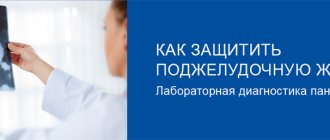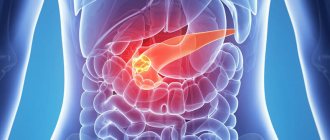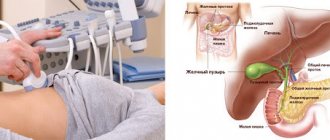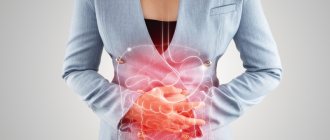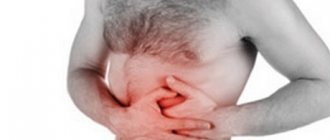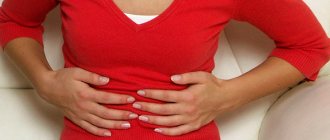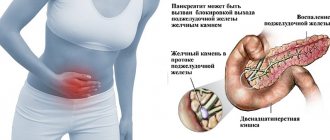Pancreatitis and cholecystitis are common diseases nowadays. Cholecystitis, a disease that affects the gallbladder, and pancreatitis, a disease that affects the pancreas, often accompany each other and therefore it is necessary to treat them together. The causes and symptoms of these diseases are largely similar to each other, and the treatment methods have a lot in common. How to treat cholecystitis and pancreatitis?
Symptoms of pancreatitis:
- pain of varying intensity, mainly in the left hypochondrium, can radiate to the lower back;
- nausea, vomiting;
- belching, heaviness in the abdomen;
- unpleasant taste in the mouth and flatulence;
- diarrhea, feces with particles of undigested food.
You should always be wary of sudden weight loss, which can occur both with chronic pancreatitis and with more serious diseases such as pancreatic cancer. Diabetes mellitus can become both a concomitant disease and a cause and even a symptom of pancreatitis.
Chronic cholecystitis and pancreatitis
A long course of chronic cholecystitis, especially calculous with the formation of stones, can cause an attack of acute pancreatitis or the gradual development of chronic biliary pancreatitis . This is due to the anatomical features of the structure of the gastrointestinal tract and the close proximity of the common bile duct and pancreatic duct. When they flow into the duodenum, the common bile duct and pancreatic duct unite and are regulated by a special muscular structure - the sphincter of Oddi.
Main symptoms
- abdominal pain and heaviness in the right hypochondrium;
- nausea, vomiting;
- unpleasant tastes in the mouth;
- bloating, flatulence, loose stools;
- weight loss, loss of appetite.
Mechanism of disease development
Possible reasons for this combination include:
- the presence of chronic cholecystitis for a long time and its ineffective treatment;
- long-term asymptomatic course of chronic calculous cholecystitis, which does not encourage patients to consult a doctor for treatment;
- the spread of obesity in the population, which contributes to the development of several interrelated gastrointestinal diseases;
- eating disorders and non-compliance with diet in chronic cholecystitis.
What diseases contribute to the development of biliary-dependent pancreatitis?
Various pathologies of the hepatobiliary zone, consisting of the liver, intra- and extrahepatic biliary tract and gallbladder, can lead to the development of acute or chronic biliary-dependent pancreatitis, an inflammatory disease of the pancreas. Such diseases include chronic cholecystitis, primarily calculous (cholelithiasis), postcholecystectomy syndrome, functional disorders of the sphincter of Oddi and gall bladder.
Why can chronic cholecystitis and other pathologies of the biliary tract cause acute or chronic pancreatitis?
Simultaneously with food processed by the stomach, bile from the common bile duct and pancreatic enzymes from the pancreatic duct should enter the duodenum. In chronic cholecystitis, small stones (up to 4 mm in diameter) and thick bile (biliary sludge) formed in the gallbladder create an obstacle to the flow of bile through the bile duct. Delayed entry of bile into the duodenum leads to a delay in the passage of food through the intestine and impaired digestion of fats. All this can lead to reflux of duodenal contents into the pancreatic duct or a delay in the flow of pancreatic enzymes from the pancreatic duct. Both of these factors cause damage to the pancreas with the development of an inflammatory process in it - pancreatitis.
In addition, if the passage of bile through the common bile duct is disrupted, the pressure in it increases and bile containing microorganisms and active substances can enter the pancreatic duct and damage the tissue of the pancreas, also causing its inflammation. Microdamage to the sphincter of Oddi by small stones (diameter up to 4 mm) leads to the appearance of neoplasms on its walls, which also impede the passage of bile and increase pressure in the bile duct.
When should you see a doctor?
If recurring abdominal pain and digestive disorders occur, consultation with a gastroenterologist is necessary to exclude chronic pancreatitis and cholecystitis.
Patients suffering from cholelithiasis for more than 10 years are at risk for chronic pancreatitis, even in the absence of any symptoms. Therefore, all patients with chronic cholecystitis are recommended to undergo treatment aimed at correcting the outflow of bile and preventing pancreatitis.
Complications
- malabsorption syndrome;
- gastrointestinal bleeding;
- pancreatic abscess;
- cholangitis;
- pancreatogenic hepatitis;
- pseudocysts;
- pancreatic necrosis;
- parapancreatitis;
- pancreatogenic ascites;
- fistulas (biliary, gastrointestinal);
- strictures and narrowing of the colon
Instrumental methods are of great importance in the diagnosis of pancreatitis, namely:
- Ultrasound;
- fibroesophagogastroduodenoscopy (FEGDS);
- endoscopic retrograde cholangiopancreatography;
- pancreatic tissue biopsy;
- plain radiography of the abdominal cavity;
- endoultrasonography;
- CT scan;
- MRI.
Gastritis is a disease accompanied by inflammation of the gastric mucosa. Often it can be caused by Helicobacter pylori infection. Gastritis can be acute or chronic.
Causes and symptoms of cholecystitis
Proper nutrition is the key to healthy gastrointestinal tract
Cholecystitis is a disease that is characterized by the occurrence of inflammatory processes in the gallbladder. This organ is located next to the liver and is directly involved in digestion. When the functions of the gallbladder are impaired, the excretory ducts do not work properly and therefore bile accumulates inside the bladder, as a result of which the patient feels severe pain, and infections may develop inside the organ.
A number of different reasons can lead to the development of this disease, the most important of which is gallstone disease. Stones that appear in the bladder often clog the ducts, which leads to disruption of their excretory function.
Also, this disease can develop due to injury, or as a result of complications of other diseases, such as diabetes. In these cases, cholecystitis is not considered an independent disease, since it is a complication of another disease. All these reasons lead to the development of an acute form of cholecystitis. If the disease is left untreated for a long time, a chronic form of the disease may develop, resulting in hardening of the gallbladder walls.
Cholecystitis most often affects people over 50 years of age. The disease is characterized by the fact that at the beginning of its onset the patient begins to feel acute pain in the right side, just below the ribs. The pain is characterized by sudden onset and often develops after the duct is blocked by a stone. After this, the inflammatory process inside the organ begins.
After some time, the pain disappears on its own or after taking a painkiller. After some time, the pain returns with even greater intensity, and there is some regularity in its appearance. The disease worsens, the patient suffers from nausea and vomiting, and his temperature rises. His general condition is deteriorating.
As a result, the excretion of bile into the intestines stops altogether. The patient's skin becomes yellow, the tongue becomes dry, with a white coating. If these symptoms appear, the patient should consult a doctor as soon as possible, since the disease in its advanced form can provoke the development of peritonitis.
Cholecystitis is a disease of the gallbladder that can occur either as a result of other serious diseases or independently. The reason for its appearance is a violation of the excretory function of the bile ducts, as a result of which bile does not enter the intestines.
What do these diseases have in common and how to treat them?
Cholecystitis and pancreatitis have similar symptoms
Both the gallbladder and the pancreas have similar functions - they produce enzymes that contribute to the normal digestion process. The first organ is responsible for dosing the bile produced by the liver so that it arrives in the right quantities, and the second organ produces pancreatic juice. If the functions of one of the organs are impaired, disturbances in the functioning of the other are observed.
Pancreatitis and cholecystitis, as is customary, are treated with medications. Therapy is often supplemented by the use of traditional medicine, as well as the prescription of a variety of diets. The main requirement for food intake in these diseases is frequent split meals. It promotes more effective action of medications used during therapy.
It is recommended to limit the consumption of foods that are too fatty and eat more healthy foods, such as steamed vegetables. It is also useful to drink a glass of kefir before bed. Typically, diseases are treated with the complex use of various drugs aimed at combating the main symptoms of the disease. Properly thought out treatment helps restore the functions of the gallbladder and pancreas. The main medications used for pancreatitis:
How to treat cholecystitis and pancreatitis using traditional methods
Often, herbal medicine is used in the treatment of cholecystitis and pancreatitis. Specially selected herbs are effective helpers in the fight against diseases. When choosing these herbs, you should pay attention to their individual tolerance, and also to the fact that many of them can increase or decrease blood pressure, are laxatives, and some of them cause constipation.
Most often, herbs are prescribed that can stop the inflammatory process. These include: dandelion root, calendula, chamomile. If there are stones in the gallbladder or gallstones, then herbs are used that will help dissolve these stones and also change the composition of bile. Together with them, herbs are used that normalize the peristalsis of the bile ducts.
Sometimes stomach enzymes affect the pancreas, stimulating it even when it should be at rest. For this reason, herbs are used to reduce the production of gastric juice. There are some ready-made recipes that can be used for pancreatitis and cholecystitis:
- Method one. Mix one part of chamomile, two parts of hawthorn berries and immortelle flowers, and three parts of mint leaves and dill seeds and pour boiling water over it all. A spoonful of the mixture should be poured into a glass of boiling water and, after it has infused, drink a quarter of the glass before meals.
- Method two. Three tablespoons of string, elecampane and mint, mixed in equal amounts, pour one and a half glasses of boiling water and, after boiling them for a couple of minutes on the fire, let it brew for an hour, then drink a third of a glass twice a day, before meals.
- Method three. Pour boiling water over a tablespoon of calendula flowers and leave for eight hours. Drink a third of a glass half an hour before meals.
Traditional medicine is also effective in combating diseases such as pancreatitis and cholecystitis. It should be used in combination with drug treatment and diet: this contributes to a more effective fight against diseases.
Cholecystitis and pancreatitis are diseases of the gallbladder and pancreas. They are similar in many ways, have similar symptoms and causes, and can appear simultaneously. For this reason, their therapy is carried out using similar methods.
